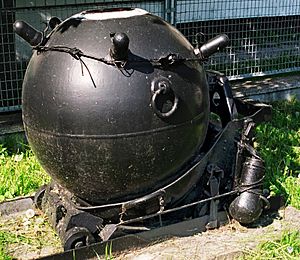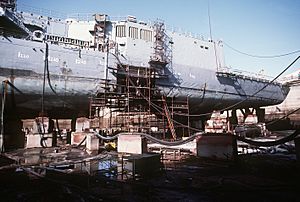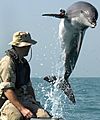Naval mine facts for kids
A naval mine is like a hidden bomb placed in the water. Its job is to destroy ships or submarines. Unlike other underwater weapons that are thrown at a target, mines are left in the water. They wait quietly until a ship or submarine comes close enough to trigger them.
Naval mines can be used in two main ways. They can be used to attack, making it hard for enemy ships to move freely. Mines can also trap enemy ships inside a harbor. They can also be used to defend. This means protecting friendly ships and creating safe areas where enemy ships cannot go.
Mines can be placed in many different ways. Special ships called minelayers can lay them. Other ships can be changed to drop mines. Submarines and even aircraft can also place mines. Sometimes, mines can even be dropped into a harbor by hand.
Naval mines are often a cheap weapon to make. A basic mine might cost around US$1000. However, some very advanced mines can cost millions of dollars. These expensive mines have many sensors. They can even launch a small rocket or torpedo to hit a target.
Rules for Placing Mines
There are international rules about placing naval mines. Countries must announce when they put mines in an area. This helps civilian ships avoid the danger. The warnings do not have to be super detailed. For example, during World War II, Britain simply said it had mined the English Channel, North Sea, and French coast.
Mines can cause a lot of damage. In 1988, an Iranian mine hit the USS Samuel B. Roberts. It blew a large hole, about 7.6 meters wide, in the ship's side. This shows how powerful even older mines can be.
Images for kids
-
A 14th-century drawing of a naval mine from the Huolongjing
-
Infernal machines in the Potomac River in 1861 during the American Civil War, sketch by Alfred Waud
-
A Vickers Wellington fitted with a DWI magnetic mine exploder, Ismailia, Egypt
-
German parachute-retarded magnetic mine. Dropped by Luftwaffe bomber during WWII and landed on the ground.
-
Camouflaged Iraqi mines hidden inside oil barrels on a shipping barge in the Persian Gulf, 2003.
-
Minesweeper USS Tide after striking a mine off Utah Beach, 7 June 1944.
-
MK 62 Quick Strike deployed from a P-3 Orion
See also
 In Spanish: Mina marina para niños
In Spanish: Mina marina para niños






















